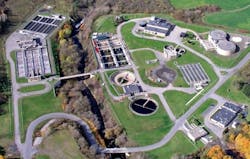Cogeneration News: New York Community Wastewater CHP plant paid for sending Excess Power to National Grid
The Gloversville-Johnstown Joint Wastewater Treatment Facility has been converting wastewater into power for the past six years.
Recently, the conversion has been so successful the municipal utility has generated more power from its cogeneration plant than it has used, according to a recent story in the local Leader-Herald newspaper. The 1.1-MW combined heat and power facility uses three engines burning methane to generate electricity.
The recent story indicated that an uptick in generation capacity has sent the excess power back into the grid and gained a financial return of about $33,000 for the community utility. New York-based utility National Grid originally assisted the municipal entity with the biogas-fired power conversion in 2015, contributing a $500,000 grant as part of the major upgrade, according to the utility.
The Gloversville-Johnstown Joint Wastewater Treatment Facility is capable of treating up to 13.8 million gallons/day (MGD) of domestic sanitary sewage and industrial wastewater, according to the municipal utility’s website. The facility treats all wastewater generated by the residents of the cities of Gloversville and Johnstown (approximately 25,000 people), plus two dozen industries, and approximately 100 users outside the corporate limits of the two cities.
A dedicated pipeline transport whey from area diary farms to an equalization tank, where it’s then pumped into a digester with anaerobes which produce gas consisting approximately of 55 percent methane, according to the municipal utility. The three combustion-engine cogeneration system then self-powers the facility.
National Grid acquires the excess electricity per a power purchase agreement.
Click here to see the Leader-Herald story.
-- -- --
(Rod Walton, senior editor for EnergyTech, is a 14-year veteran of covering the energy industry both as a newspaper and trade journalist. He can reached at [email protected]).
About the Author
Rod Walton, EnergyTech Managing Editor
Managing Editor
For EnergyTech editorial inquiries, please contact Managing Editor Rod Walton at [email protected].
Rod Walton has spent 17 years covering the energy industry as a newspaper and trade journalist. He formerly was energy writer and business editor at the Tulsa World. Later, he spent six years covering the electricity power sector for Pennwell and Clarion Events. He joined Endeavor and EnergyTech in November 2021.
Walton earned his Bachelors degree in journalism from the University of Oklahoma. His career stops include the Moore American, Bartlesville Examiner-Enterprise, Wagoner Tribune and Tulsa World.
EnergyTech is focused on the mission critical and large-scale energy users and their sustainability and resiliency goals. These include the commercial and industrial sectors, as well as the military, universities, data centers and microgrids. The C&I sectors together account for close to 30 percent of greenhouse gas emissions in the U.S.
He was named Managing Editor for Microgrid Knowledge and EnergyTech starting July 1, 2023
Many large-scale energy users such as Fortune 500 companies, and mission-critical users such as military bases, universities, healthcare facilities, public safety and data centers, shifting their energy priorities to reach net-zero carbon goals within the coming decades. These include plans for renewable energy power purchase agreements, but also on-site resiliency projects such as microgrids, combined heat and power, rooftop solar, energy storage, digitalization and building efficiency upgrades.

